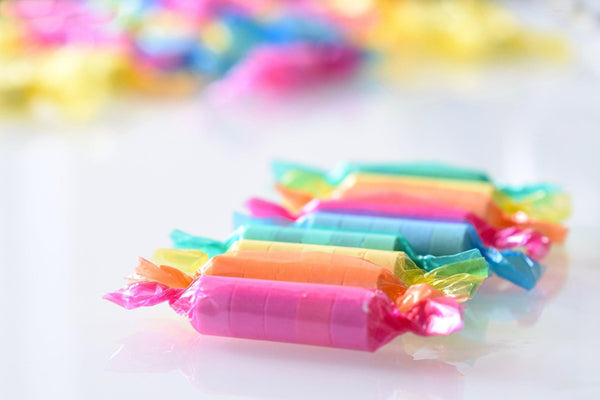
Jump to:
We all know Japanese food is amazing - sushi, tempura, takoyaki - but what about Japanese candy? There are tons of candies in Japan - most that you don’t see in the West. From sweet to sour, gummies to hard candies, there is no lack of variety. This article will tell you everything you want to know about Japanese candy - from taste to texture to the seemingly strange - and compare it with candies of the West.
History Of Japanese Candy
Candy has been popular in Japan for centuries. Hundreds of years ago, there weren’t so many varieties, but now the choices are endless. Traditional Japanese candy from the Edo period (1603–1867) was called wagashi. It’s still around today, but wagashi are more like confections than candy (made often from mochi and bean products). So these wouldn’t be considered actual candy by many today - except in a case like konpeito. Konpeito is an actual candy that is still in stores today.
Differences Between Western And Japanese Candy

The most noticeable difference between Japanese and Western candy is probably how sweet it is. Japanese candy is sweet - yes - but compared to candies in the West, it doesn’t usually reach that same sweetness level. Japanese candies tend to be more on the sour side, too. Western candies, even if they’re sour, are still sweeter most of the time. Japanese candy also tends to have some flavors that Westerners might find unusual - like matcha for example (an edible green tea).
Another difference between Japanese candies and Western ones is the serving size. You’ll notice that the sizes of candy packages are a bit smaller in Japan. This is not unique to candy, though, as portion sizes of food also tend to be smaller in Japan than in the West.
One other major difference between Western and Japanese candies is Japan’s willingness to be creative with their candies. You can find candy themed around toilets, rock gardens, anime, slime and more. There are also candies you can make yourself from liquid and powders.
Types Of Japanese Candy
Where do we begin? There are so many types of candy in Japan. Let’s break them down into a few broad categories first: hard candy, soft candy, and gummies (yes, gummy candy is soft, too, but it’s getting its own category).
Japanese Hard Candy

Hard candies are the ones that are - you guessed it - hard! Popular Japanese hard candies include:
- Mitsuya Cider Candy - This one actually fizzes in your mouth!
- Basic Flavored Hard Candy - It comes in all kinds of flavors (Pineapple, Mint, Melon, etc.) - it’s basically a fruit drop.
- Konpeito - The Japanese star candy - a hard candy with a long history, yet so many flavors to choose from!
- Soda Candy - You’ll see a lot of soda flavored candy in Japan, but one stands out in particular: Ramune soda candy. It’s delicious and has a unique texture and flavor. It really tastes like soda and sort of dissolves in your mouth after you chew it.
- Rock Candy - There are a few varieties of rock candy, but an interesting example is Japanese crystal candy. It’s very hard and has a beautiful crystalline, rock-like appearance.
- Peanut Candy - Yes, Japan does peanuts in candy, too (occasionally). One great peanut candy is called Kanro Nutbon Caramel Peanut Crunch Candy. It’s nutty, crunchy and so delicious.
Japanese Soft Candy

Soft candies tend to be soft (obviously) and chewy. There are many types of soft candy in Japan - jelly beans, taffy and more. Some of the most popular soft candies in Japan are:
- Taffy - A number of taffy-like candies are available, but perhaps the most popular is Hi-Chew. If you like Starburst (Western candy), then Hi-Chew is a great choice. It has that fruity, taffy quality.
- Jelly Beans - There are so many types of jelly beans in Japan - including Poifull (sweet and sour) and Kasugai Tsubu Gummy (ok, it’s called a gummy, but to a western eye and palette, it’s a jelly bean)
- Milk Candy - Want a candy that’s sweet and milky? Well, Japan has you covered. You should try the candy called “Milky.” It’s chewy and (you guessed it) milky.
- Jelly and Gelatin Candy - Okay, whether this is actually a candy or not is debatable. It’s a gelatin, Jell-O, type of snack. So is it really a candy? We leave it to you to decide.
Japanese Gummy Candy

Wow, there is so much Japanese gummy candy. Sometimes, when you’re roaming the candy aisle of a Japanese convenience store, it seems almost all of the candies are gummies. Here are a few types you can find.
- Soft Gummies - So delicious. Flavors ranging from cola to grape to orange - often in cute little shapes to resemble their flavors. They’re tender and juicy. The mandarin gummies are especially good!
- Hard Gummies - These are a bit unique - chewy gummies that take longer than usual to eat. Why? Because they’re tough and almost hard. But they have great flavor, too - just a different consistency than soft gummies.
- Liquid-Filled Gummies - These are gummies with juicy centers that burst in your mouth. Yum!
Unusual Japanese Candy

There are some really unusual (and almost unbelievable) candies available in Japan. For example, the infamous toilet bowl “candy.” You get a small plastic toilet bowl and fill it with liquid and powder. Then it fizzes up in the toilet bowl and you suck it out with a straw. Sound appetizing? Anyway, the toilet bowl candy may not technically qualify as candy, because it’s more like a drink - but it at least deserves an honorable mention. Here are some other unusual and unique candies you can find in Japan.
- Edible Japanese Rock Garden - It really looks like a beautiful miniature rock garden, but you can eat it! Even the fish pond. Get your inner peace and fill your sugar craving at the same time. See it on YouTube here.
- Tsureta Fishing Gummy Candy - This one is unusual. You actually create the candy from powder and water and go “fishing” with a little stick. When you dip your “fishing pole” into the liquid, a gooey thing (that doesn’t look like a fish) will come up out of the water on your stick. You might need to see it to believe it.
- Hi-Chew Taste Changing Candy - Can’t decide what flavor you want? Well, this candy let’s you have your “candy” and eat it, too. It changes flavors while you chew it!
- Giant Jellyfish Caramels - That’s right. This candy is made from a huge jellyfish. It’s called Nomura’s Jellyfish. There are so many of these jellyfish near Japan that it has become a bit of a nuisance to fishermen. What do fishermen do with all of that unwanted jellyfish? Make candy out of it, of course. Note: Although some recent articles refer to this candy, it is unclear where it can be purchased.
- Dragon Quest Slime Candy - Yes, it’s actually slimy - like the cute little slimes in Dragon Quest (the famous Japanese video game). But this type of candy is actually called uiro. Uiro has a long history and is more like a mochi, but this is a more slimy version than usual.
Themed Japanese Candy
Another type of candy you can find in Japan is candy themed around anime characters (and some Disney characters). There are quite a few that are popular - including Pokemon, Hello Kitty and Frozen. Perhaps the most appealing part of candies like this is the packaging. The tastes and textures of the candies vary as much as Japanese candy does in general. So, if you love a certain anime or a particular character, this candy is a must try - and maybe a collectors item, too.
- Pokemon - Gotta eat `em all! (that is a throwback to the American catch phrase of Pokemon, if you didn’t recognize it). Anyway, you can get all kinds of Pokemon candy in Japan with your favorite pocket monsters all over the packaging.
- Disney - Yes, Disney is popular in Japan, too. But the Disney candies you get in Japan are obviously marketed to a Japanese audience, so the packaging is not what you’ll see in the West. There are candies featuring Mickey and Minnie Mouse, Donald Duck, characters from Frozen and more. One especially interesting candy is the DIY Disney princess gummy candy kit (try saying that five times fast). See it in action on YouTube.
- Dragon Quest - Yes! Dragon Quest is one of the most popular Japanese video games in the world, and Dragon Quest is still very popular in Japan. One of the most popular characters (or “monsters”) from the game is the cute little slime. You can find slime candy and all kinds of Dragon Quest character candies at Square Enix (the company that owns the game). Flavors include lime, mandarin orange, cherry and more!
What Is The Best Japanese Candy?

Honestly, the best Japanese candy is all in the eye of the beholder… or is that “in the tongue of the taster?” Everyone’s preference is different, but if you're curious about which candy people in Japan like best, we can get some idea. According to Amazon Japan`s list of best selling sweets (not counting the breath mints), the top selling candy in Japan is the sweet and soda-like Ramune soda candy!
Can You Get Western Candy in Japan?
Often the brands of candy that are available in Japan are different from the West. For example, in the West you have Skittles - those chewy, fruit-flavored discs with a huge variety of flavors. In Japan, Skittles are a rarity, and there aren’t many candies that can compare - perhaps Mentos is the closest alternative available in Japan.
Other popular candies that you can hardly ever find in Japan include Starburst, Jolly Ranchers, Nerds and pretty much all licorice candy. Who likes licorice candy anyway? (This writer does!) For Starburst, there’s a similar candy called Hi-Chew. For Jolly Ranchers (popular in America), there are many suckable candies that are similar (but sorry, not as good). Nerds - also popular in America - pretty much have no replacement, but the rock-like konpeito could be comparable. And licorice, oh, it’s just not a popular Japanese candy at all.
Why Should You Try Japanese Candies?
You should try Japanese candy if you enjoy trying something different. There is quite an assortment of flavors and textures in Japanese candy. Plus, there are some candies that can actually be fun to make - like the DIY candy making kits and candy rock gardens. There are even some highly unusual candies like the ones made from jellyfish, too. So if you’re feeling adventurous, try some Japanese candy!


0 comments